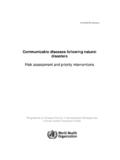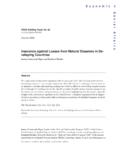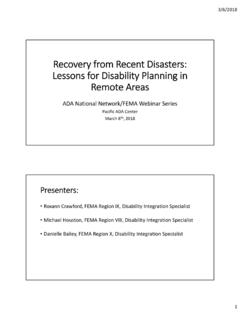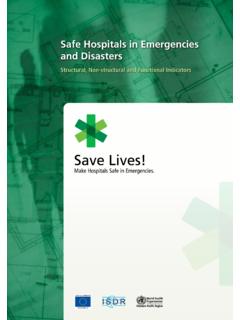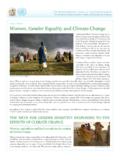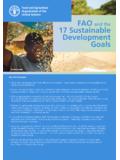Transcription of Trends of Natural Disasters – the Role of Global Warming
1 Trends of Natural Disasters the Role of Global WarmingProf. Dr. Peter HoeppeGeo Risks ResearchMunich Reinsurance CompanyGeo Risks Research Department of Munich Re -Analyses of Natural Disasters since 1974 Staff: 291 based at Munich Re Americain Princeton2 based inHong Kong officeCommunication on Climate Changeas a relevant risk in insurance industry for many yearsTrends of Natural DisastersThe last years have brought records in Natural Disasters in respect to: Intensities Frequencies Damages and losses UTC13:00 Heat stressCold stresslightextremehighmoderatelightcomfo rtablemoderatehighextremeHeat wave of 2003, the largest humanitariannatural catastrophe in Europe for centuries15,000 15,000 7,000 7,000 4,000 4,000 2,000 2,000 2,000 2,000 4,000 4,000 Perceived Temperature on 8 August 2003 and excess mortalitySource: German Weather Service, 2004 Source: Image courtesy of Earth Sciences and Image Analysis Laboratory, NASA Johnson Space Center, Bild-NummerISS008-E-19646.
2 : 1st Hurricane in South AtlanticHurricane Catarina off the Coast of Brasil, March 2004 July/August 2005 Flooding in India944 mm rain within 24 hours, highest ever in Flooding in India ( fatalities)Insured losses (US$ m):Economic losses (US$ m) 770source: Hurricane Katrina, USA ( fatalities)August 2005 Hurricane Katrina6th strongest hurricane, largest losses of a single eventInsured losses (US$ m):Economic losses (US$ m) (NFIP included) 2005, a Year of Weather ExtremesNever before since the beginning of records (1850) have so many named tropical storms occurred in the North Atlantic basin in one season: 28, of which 15 with hurricane strength (old absolute record 21 in 1933, resp.)
3 12 in 1969) Hurricane Vince (9 October 2005)Vince, a hurricane in a region without hurricane risk (easterly North Atlantic, Madeira)MR NatCatSERVICE One of the world s largest databases on Natural catastrophesThe database today: From 1980 until today all loss events have been analysed andentered (19,000 data sets) For USA and selected countries in Europe all loss events between 1970 and 1980 - other countries will follow consecutively (1,000 data sets) Retrospectively all Great Disasters since 1950 have been analysed and entered (276 data sets) In addition all major historical events starting from 79 AD eruption of Mt. Vesuvio (3,000 historical data sets)more than 23,000 events0246810121416195019551960196519701 975198019851990199520002005 Great Natural Disasters 1950 2006 Number of eventsTemperature extremes ( heat wave, wildfire)StormFloodEarthquake, tsunami, volcanic eruption 2007 NatCatSERVICE,Geo Risks Research, Munich ReNumber02040608010012014016018019501955 1960196519701975198019851990199520002005 Great Weather Disasters 1950 2006 Overall and insured losses 2007 NatCatSERVICE, Geo Risks Research, Munich ReUS$ bnEconomic losses (2006 values) Insured losses (2006 values) * According to the definition criteria there was no Great Weather disaster in 2006.
4 * 90% of insured losses caused by windstormsIndia: Weather Disasters 1980 2006 Number of events, with trendtemperaturesExtreme StormFloodsWeather events 2006 NatCatSERVICE , Geo Risks Research, Munich Re05101520253019801982198419861988199019 9219941996199820002002200420060102030405 0607080198019821984198619881990199219941 996199820002002200420061 Small-scale loss event2 Moderate loss event3 Severe catastrophe4 Major catastrophe5 Devastating catastrophe6 Great Natural catastrophe (none)Thunderstorms*USA 1980 2006 Number of events with trendNumber 2007 NatCatSERVICE, Geo Risks Research, Munich Re* Thunderstorms including tornado outbreaks and hailstorms(<765)(765-3035)(>9385) (3036-9385) (<765)(765-3035)(>9385) (3036-9385)
5 Natural catastrophes in economies at different stages of development between 1980 and 2005 Global distribution of insurance premiums per capita 2006 Geo Risks Research, Munich ReHurricane losses in the selected Caribbean Statesin 2004 (GDP%) Dom. Cayman compared to annual GDP 2005 Geo Risks Research, Munich ReLess problematic Rise in population Better standard of living Increasing insurance densityProblematic Concentration of people and values in large conurbations Settlement in and industrialization of extremely exposed regions Change in environmental conditions - Climate ChangeReasons for globally increasing losses due to Natural Disasters -0,5-0,3-0,10,10,30,51856187618 9619161936195619761996-0,5-0,3-0,10,10,3 0,5 Global mean temperature, 1856 - 2006 Departures in temperature from the 1961-1990 average2006: + Cabove the 1961-1990 annual average (14 C).
6 The five warmest years in decreasing order are: 1998, 2005, 2002, 2003 and 2004. Temperature anomaly ( C)Source: CRU, UK (2007), compilation acc. to WMOAll the 10 warmestyears were in the last 12 and Regional Temperature Trends in the 20th century: modeled and observedSource: , Oxford University+ C + CCO2concentration in the atmosphereof the past 650,000 years from the Vostok ice core, Antarctica160180200220240260280300320340 360380400-650 -600 -550 -500 -450 -400 -350 -300 -250 -200 -150 -100 -500 Thousand years before presentCO2 (ppmv)2006: 383 ppmv CO2 Sources: Siegenthaler et al. (2005), Spahni et al.
7 (2005), R thlisberger et al. (2004)Scientific evidence of a link between Global Warming and tropical storm intensification Global Warming will intensify the maximum wind speed by on the SaffirSimpson scale and precipitation by 18% in hurricanes until 2050 (Knutson etal., J of Climate 2004). Major tropical storms both in the Atlantic and the Pacific region have alreadyincreased since the 1970s in duration and intensity by about 50 percent(Emanuel, Nature 2005; Webster, Science 2005) Due to climate change the sea surface temperatures have increased alreadyby C (Barnett, Pierce, 2005, Science; Santer et al., PNAS, Sept. 2006) Of all the factors that drive a major storm only the steady increase in seasurface temperatures over the last 35 years can account for the risingstrength of storms in six ocean basins around the world (Hoyos et al.)
8 , Science 2006)Projections of air temperature changes relative to 1980-1999 (IPCC, 2007)Changes in sea level since 1850 Source: IPCC 4thAR, WGI, Paris, sea level rise in the 21st century: 18 59 cm with no increase in ice flow rates in Greenland and Antarctica included IPCC assessment climate change and extreme weather events (2 February, 2007) Regional, at least country specific prospective risk assessment and mappingnecessary Policies to Cope with Climate Change EffectsRisk mapping with Munich Re NATHAN Regional, at least country specific prospective risk assessment and mappingnecessary Region specific prevention and adaptation measures Regional strategies to cope with losses from Disasters induced by globalwarmingIn developed countries: traditional insurance schemesIn developing countries.
9 Micro insurance, donor based insurancemechanisms Mitigation of causes of Global warmingPolicies to Cope with Climate Change EffectsThe Munich Climate Insurance Initiative (MCII)The MCII was founded by representatives of Germanwatch, IIASA, Munich Re, the Potsdam Institute for Climate Impact Research (PIK), the Swiss Federal Institute of Technology (SLF), the Tyndall Centre, the World Bank, and independent Wealthy countries will be able to cope with financial losses from increasingdisasters by means of insurance solutions and state funding, the poorest countries will suffer mostObjectives The increasing Natural catastrophe damages in poor countries will consumeincreasing ratios of the donor money of development funding, delaying their further development New insurance related systems are necessary to get these countries, where currently almost no insurance is available, out of the Global Warming trap MCII is working on solutions to provide expertise on insurance related mechanisms to cover losses due to climate change.
10 Especially in developing countriesInsuredInsurerReinsurerunlimite dup to up to nownowInsurer GovernmentInsuredReinsurerlimitedfuturef uturesolutionsolution??Insurance of Natural HazardsCarrier of the burden/liabilitiesMunich Re: many activities to promote climate protection - Member of The Climate Group- Member of the Global Roundtable on Climate Change (Jeff Sachs)- Board member of the European Climate Forum- Hosting side events at the annual Global climate summits of theUNFCCC (COP)- UNEP-Financial Initiative- Carbon Disclosure ProjectIncrease of corporate responsibility activitiesin the field of climate changePublications and strategic board gameConclusions Natural catastrophes, especially weather related events, areincreasing dramatically in number and magnitude.










